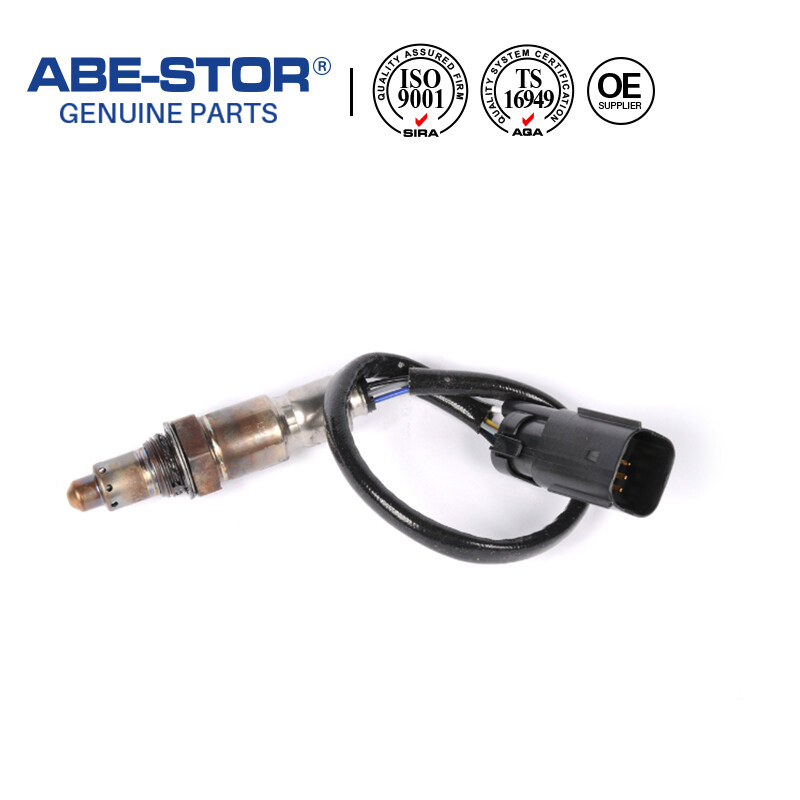Email format error
Email cannot be empty
Email already exists
6-20 characters(letters plus numbers only)
The password is inconsistent
Email format error
Email cannot be empty
Email does not exist
6-20 characters(letters plus numbers only)
The password is inconsistent


Chevrolet Cruze Oxygen Sensor: A Comprehensive Guide to Understanding and Maintaining Your Vehicle’s Oxygen Sensor
The oxygen sensor is a critical component in the Chevrolet Cruze’s engine management system. It measures the oxygen levels in the exhaust gases and provides feedback to the engine control unit (ECU) for optimal fuel-air mixture control. This post will provide a comprehensive guide to understanding and maintaining the Chevrolet Cruze oxygen sensor in the Chevrolet Cruze.
Importance of the Oxygen Sensor in the Chevrolet Cruze?
The oxygen sensor plays a vital role in ensuring the engine runs efficiently and meets emission standards. It helps maintain the right air-fuel ratio, improves fuel economy, reduces harmful emissions, and prevents engine damage. Understanding its function and knowing how to maintain and replace it is essential for the overall performance of your Chevrolet Cruze.
Section 1: Understanding the Oxygen Sensor
What is an Oxygen Sensor?
An oxygen sensor, also known as an O2 sensor, is a small electronic device located in the exhaust system of the Chevrolet Cruze. Its primary function is to measure the oxygen content in the exhaust gases and provide feedback to the engine control unit (ECU). This information is crucial for the ECU to adjust the fuel injection and ignition timing, ensuring optimal engine performance.
The oxygen sensor consists of a ceramic element coated with a mixture of platinum and palladium. This coating acts as a catalyst, facilitating the chemical reaction between oxygen and the exhaust gases. As the exhaust gases pass over the sensor, the oxygen in the gases reacts with the platinum and palladium, generating a voltage signal.
How Does an Oxygen Sensor Work?
The oxygen sensor operates based on the principle of the Nernst equation. It compares the oxygen concentration in the exhaust gases with the oxygen concentration in the outside air. The difference in oxygen levels creates a voltage potential across the sensor.
The sensor has two chambers: a reference chamber and a measurement chamber. The reference chamber is exposed to the outside air, while the measurement chamber is exposed to the exhaust gases. The ceramic element acts as a barrier between the two chambers, allowing oxygen ions to pass through.
When the oxygen concentration in the exhaust gases is higher than in the outside air, oxygen ions flow from the measurement chamber to the reference chamber, creating a voltage difference. Conversely, when the oxygen concentration in the exhaust gases is lower, the flow of oxygen ions reverses, resulting in a different voltage signal.
The voltage signal generated by the oxygen sensor is sent to the ECU, which uses this information to adjust the fuel-air mixture. If the sensor detects a rich mixture (excess fuel), the ECU will reduce the fuel injection to achieve a more balanced ratio. Similarly, if the sensor detects a lean mixture (insufficient fuel), the ECU will increase the fuel injection.
Types of Chevrolet Cruze Oxygen Sensors
The Chevrolet Cruze may have either a heated or unheated oxygen sensor, depending on the model and year. The main difference between the two types is the presence of an internal heating element in the heated sensor.
Heated oxygen sensors have an electric heating element that helps them reach operating temperature quickly. This is particularly important during cold starts when the exhaust gases may not be hot enough to activate the sensor. By reaching operating temperature faster, heated sensors provide more accurate readings and improve overall engine performance.
Unheated oxygen sensors, on the other hand, rely on the heat generated by the exhaust gases to reach their operating temperature. They take longer to warm up, which can result in delayed and less accurate readings during cold starts. However, once they reach operating temperature, they function similarly to heated sensors.
It is essential to know which type of oxygen sensor your Chevrolet Cruze has to ensure proper maintenance and replacement. Consult your vehicle’s manual or consult with a qualified mechanic to determine the type of oxygen sensor in your specific model.
Section 2: Signs of a Faulty Oxygen Sensor
Common Symptoms of a Faulty Oxygen Sensor:
- Decreased fuel efficiency: A faulty oxygen sensor can cause the engine to run rich or lean, resulting in poor fuel economy. If you notice a significant decrease in your Chevrolet Cruze’s fuel efficiency, it could be a sign of a faulty oxygen sensor.
- Rough idling: An oxygen sensor that is not functioning properly can cause the engine to idle roughly or inconsistently. You may experience vibrations or a shaky engine when the vehicle is at a standstill.
- Engine misfires: A malfunctioning oxygen sensor can lead to incorrect fuel-air mixture, which can cause engine misfires. You may notice a loss of power, hesitation, or jerking while accelerating.
- Increased emissions: The oxygen sensor plays a crucial role in controlling emissions. If it is faulty, the engine may produce higher levels of harmful pollutants, leading to increased emissions. This can result in a failed emissions test or the illumination of the check engine light.
- Illumination of the check engine light: One of the most common signs of a faulty oxygen sensor is the illumination of the check engine light on the dashboard. The ECU detects irregularities in the oxygen sensor’s readings and triggers the check engine light to alert you of a potential issue.
Recognizing these symptoms can help you diagnose and address any potential oxygen sensor problems in your Chevrolet Cruze. If you experience any of these signs, it is recommended to have your vehicle inspected by a qualified mechanic or use an OBD-II scanner to retrieve error codes related to the oxygen sensor.
Diagnostic Methods for Identifying Oxygen Sensor Issues:
OBD-II Scanner: An OBD-II scanner is a diagnostic tool that can retrieve error codes from the vehicle’s onboard computer system. By connecting the scanner to the OBD-II port in your Chevrolet Cruze, you can access specific error codes related to the oxygen sensor. These codes can provide valuable information about the nature of the problem and guide you in the troubleshooting process.
Visual Inspection: A visual inspection of the oxygen sensor can help identify any physical damage or signs of contamination. Look for signs of corrosion, loose connections, or damaged wiring. If you notice any abnormalities, it may indicate a faulty sensor that needs to be replaced.
Voltage Test: Using a multimeter, you can perform a voltage test to check the output of the oxygen sensor. This test requires disconnecting the sensor and connecting the multimeter to the sensor’s signal wire. Start the engine and observe the voltage readings. A properly functioning oxygen sensor should fluctuate between 0.1 to 0.9 volts in a regular pattern. If the voltage remains steady or shows no activity, it indicates a faulty sensor that needs to be replaced.
Sensor Response Test: Another diagnostic method is to perform a sensor response test. This involves using a scan tool or oscilloscope to monitor the oxygen sensor’s response to changes in the fuel-air mixture. By introducing a lean or rich condition, you can observe how quickly and accurately the sensor responds. A slow or inaccurate response may indicate a faulty sensor.
Section 3: Replacing the Chevrolet Cruze Oxygen Sensor
When Should You Replace the Oxygen Sensor?
● Oxygen sensors typically have a lifespan of 50,000 to 100,000 miles, but this can vary depending on driving conditions and fuel quality.
● It is recommended to replace the oxygen sensor when it fails or reaches its expected lifespan.
● Regular maintenance and inspection can help you determine when it’s time for a replacement.
● Step-by-Step Guide to Replacing the Oxygen Sensor in the Chevrolet Cruze:
a. Tools Required:
Gather the necessary tools before starting the replacement process. You will need a wrench, socket set, and an O2 sensor removal tool. It’s important to have the right tools to ensure a smooth and successful replacement.
b. Locating the Oxygen Sensor:
Identify the location of the oxygen sensor in your Chevrolet Cruze. The number and location of sensors may vary depending on the specific model and year of your vehicle. Refer to the vehicle’s service manual or consult with a qualified mechanic for the exact location.
c. Removing the Old Oxygen Sensor:
Safely remove the old oxygen sensor using the appropriate tools. This may involve disconnecting electrical connectors and using a wrench or socket set to loosen and remove the sensor from its mounting location. Take care not to damage any surrounding components during the removal process.
d. Installing the New Oxygen Sensor:
Install the new oxygen sensor, ensuring proper alignment and connection. Follow the manufacturer’s instructions for installation, as the process may vary depending on the specific sensor. Use the appropriate tools to tighten the sensor securely in its mounting location.
e. Testing the New Oxygen Sensor:
After installation, it is important to test the new oxygen sensor to ensure it is functioning correctly. Start the engine and monitor the sensor’s voltage readings using an OBD-II scanner or multimeter. The readings should fluctuate within the expected range, indicating that the sensor is providing accurate feedback to the ECU.
Section 4: Maintaining the Chevrolet Cruze Oxygen Sensor
Tips for Maintaining the Oxygen Sensor:
● Regularly inspect the oxygen sensor for damage or contamination. Look for signs of physical damage, such as cracks or corrosion, and ensure that the sensor is securely mounted.
● Use high-quality fuel to minimize the risk of fuel contaminants affecting the sensor’s performance. Poor-quality fuel can lead to the buildup of deposits on the sensor, reducing its accuracy.
● Avoid excessive idling, as prolonged idling can lead to the accumulation of carbon deposits on the sensor. This can affect its ability to provide accurate readings.
Cleaning the Oxygen Sensor:
● Cleaning the oxygen sensor can help remove carbon deposits and improve its accuracy. However, it is crucial to use a sensor-safe cleaner and follow the manufacturer’s instructions.
● Sensor-safe cleaners are specifically designed to clean oxygen sensors without causing damage. Avoid using harsh chemicals or solvents that can harm the sensor.
● Follow the manufacturer’s instructions for cleaning, which may involve removing the sensor and soaking it in the cleaner or using a spray cleaner directly on the sensor. Take care not to damage the sensor during the cleaning process.
Common Mistakes to Avoid When Maintaining the Oxygen Sensor:
● Avoid using silicone-based sealants on the sensor or its mounting location. Silicone can contaminate the sensor and affect its performance. Use the recommended sealant, if necessary, and ensure it is compatible with oxygen sensors.
● Do not over-tighten the sensor during installation. Over-tightening can damage the sensor or its threads, leading to leaks or improper functioning. Follow the recommended torque specifications provided by the manufacturer.
● Use only cleaning agents that are compatible with oxygen sensors. Using non-compatible cleaning agents can damage the sensor and compromise its accuracy. Refer to the manufacturer’s instructions or consult a qualified mechanic for guidance on suitable cleaning agents.
Section 5: Frequently Asked Questions about the Chevrolet Cruze Oxygen Sensor?
Q1: How Often Should the Oxygen Sensor be Replaced?
The oxygen sensor should be replaced when it fails or reaches its expected lifespan, typically between 50,000 to 100,000 miles. However, regular maintenance and inspection can help identify any issues and determine if replacement is necessary.
Q2: Can a Faulty Oxygen Sensor Affect Fuel Efficiency?
Yes, a faulty oxygen sensor can lead to decreased fuel efficiency. When the sensor fails to provide accurate readings, the engine control unit may not adjust the fuel-air mixture correctly, resulting in poor fuel economy.
Q3: Can a Faulty Oxygen Sensor Cause Engine Misfires?
A faulty oxygen sensor can contribute to engine misfires. If the sensor provides incorrect readings, the engine control unit may not deliver the right amount of fuel, leading to misfires and rough engine performance.
Conclusion
In conclusion, the Chevrolet Cruze oxygen sensor is a crucial component in the engine management system. It plays a vital role in maintaining the right air-fuel ratio, improving fuel economy, reducing emissions, and preventing engine damage. Understanding its function and knowing how to maintain and replace it is essential for optimal performance. By recognizing the signs of a faulty oxygen sensor, conducting proper diagnostic methods, and following the step-by-step guide for replacement, you can ensure the longevity and efficiency of your Chevrolet Cruze’s oxygen sensor. Regular maintenance and inspection, along with proper cleaning techniques, will further contribute to its accurate performance. Overall, taking care of the oxygen sensor will help your Chevrolet Cruze run smoothly and meet emission standards.

